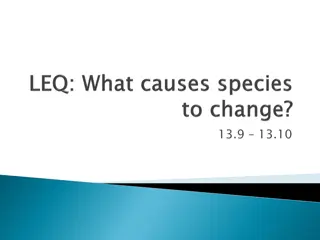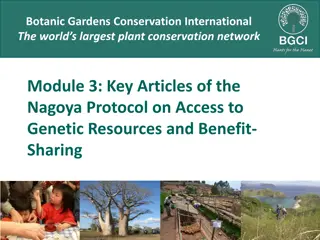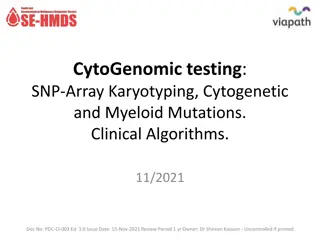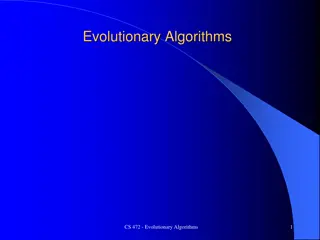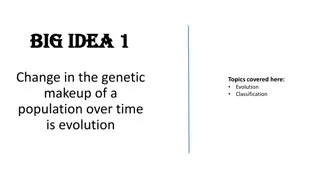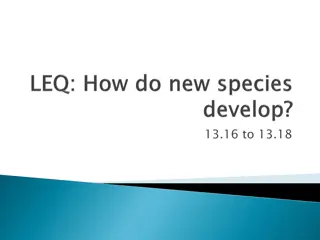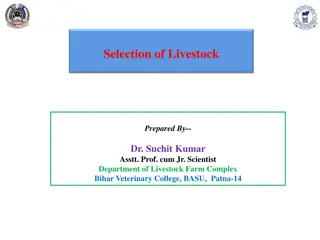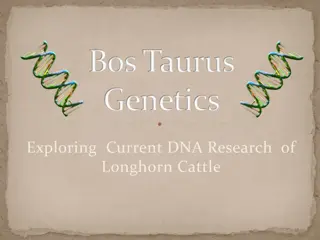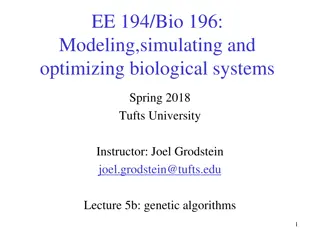Understanding Genetic Algorithms and Natural Selection
Genetic Algorithms (GAs) are based on Darwin's Principle of Natural Selection. Introduced in the 1960s, they use evolutionary computing to optimize solutions. The process mimics nature, where the best traits survive and propagate, leading to the evolution of species. Through examples like giraffes and the struggle for existence among animals, GAs showcase how advantageous traits are inherited and passed on through generations.
Uploaded on Jul 23, 2024 | 0 Views
Download Presentation

Please find below an Image/Link to download the presentation.
The content on the website is provided AS IS for your information and personal use only. It may not be sold, licensed, or shared on other websites without obtaining consent from the author. Download presentation by click this link. If you encounter any issues during the download, it is possible that the publisher has removed the file from their server.
E N D
Presentation Transcript
History Of Genetic Algorithms Evolutionary Computing was introduced in the 1960s by I. Rechenberg. John Holland wrote the first book on Genetic Algorithms Adaptation in Natural and Artificial Systems in 1975. In 1992 John Koza used genetic algorithm to evolve programs to perform certain tasks. He called his method Genetic Programming . 3
What Are Genetic Algorithms (GAs)? Genetic Algorithms are search and optimization techniques based on Darwin s Principle of Natural Selection. 4
Darwins Principle Of Natural Selection IF there are organisms that reproduce, and IF offsprings inherit traits from their progenitors, and IF there is variability of traits, and IF the environment cannot support all members of a growing population, THEN those members of the population with less- adaptive traits (determined by the environment) will die out, and THEN those members with more-adaptive traits (determined by the environment) will thrive The result is the evolution of species. 5
Basic Idea Of Principle Of Natural Selection Select The Best, Discard The Rest 6
An Example of Natural Selection Giraffes have long necks. Giraffes with slightly longer necks could feed on leaves of higher branches when all lower ones had been eaten off. They had a better chance of survival. Favorable characteristic propagated through generations of giraffes. Now, evolved species has long necks. NOTE: Longer necks may have been a deviant characteristic (mutation) initially but since it was favorable, was propagated over generations. Now an established trait. So, some mutations are beneficial. 7
Evolution Through Natural Selection Initial Population Of Animals Struggle For Existence-Survival Of the Fittest Surviving Individuals Reproduce, Propagate Favorable Characteristics Millions Of Years Evolved Species (Favorable Characteristic Now A Trait Of Species) 8
Genetic Algorithms Implement Optimization Strategies By Simulating Evolution Of Species Through Natural Selection. 9
Taxonomy Search Techniques Uninformed Informed DFS BFS Evolutionary Algorithms Simulated Annealing A* Hill Climbing Evolutionary Strategies Swarm Intelligence Genetic Programming Genetic Algorithms
Working Mechanism Of GAs Begin Initialize population Evaluate Solutions T =0 N Optimum Solution? Selection Y T=T+1 Crossover Stop Mutation 11
Simple Genetic Algorithm Simple_Genetic_Algorithm() { Initialize the Population; Calculate Fitness Function; While(Fitness Value != Optimal Value) { Selection; //Natural Selection, Survival Of Fittest Crossover; //Reproduction, Propagate favorable characteristics //Mutation Mutation; } Calculate Fitness Function; } 12
Nature to Computer Mapping Nature Computer Population Individual Fitness Chromosome Gene Reproduction Set of solutions. Solution to a problem. Quality of a solution. Encoding for a Solution. Part of the encoding of a solution. Crossover 13
Components of a GA A problem to solve, and ... Encoding technique (gene, chromosome) (creation) Initialization procedure Evaluation function (environment) (reproduction) Selection of parents Genetic operators (mutation, recombination) Parameter settings (practice and art)
GA terminology Population The collection of potential solutions (i.e. all the chromosomes) Parents/Children Both are chromosomes Children are generated from the parent chromosomes Generations Number of iterations/cycles through the GA process
Genotype, Phenotype, Population Genotype chromosome Coding of chromosomes coded string, set of coded strings Phenotype The physical expression Properties of a set of solutions Population a set of solutions 16
The GA cycle chosen parents recombination children selection modification modified children parents evaluation population evaluated children deleted members discard
Encoding The process of representing the solution in the form of a string that conveys the necessary information. Just as in a chromosome, each gene controls a particular characteristic of the individual, similarly, each bit in the string represents a characteristic of the solution. 19
Encoding Methods Binary Encoding Most common method of encoding. Chromosomes are strings of 1 s and 0 s and each position in the chromosome represents a particular characteristic of the problem. Chromosome A 10110010110011100101 Chromosome B 11111110000000011111 20
Genetic Algorithms: Binary-Coded Representations For Example, let s say that we are trying to optimize the following function, f(x) = x2 for 2 x 1 If we were to use binary-coded representations we would first need to develop a mapping function form our genotype representation (binary string) to our phenotype representation (our Candidate Solution). This can be done using the following mapping function: d(ub,lb,l,chrom) = (ub-lb) decode(chrom)/2l-1 + lb
Binary-Coded Representations d(ub,lb,l,c) = (ub-lb) decode(c)/2l-1 + lb , where = 2, = 1, = the length of the chromosome in bits = the chromosome The parameter, l, determines the accuracy (and resolution of our search). ub lb l c
Binary Coded Representations Individual Individual Chromosome: 00101 Fitness = ????? Chromosome: 00101 Fitness = 1.35 2.69 d(2,1,5,00101) = 1.16 f(1.16) = 1.35 (1.64)=2.69 1.65 The Fitness Assignment Process for Binary Coded Chromosomes (ub=2, lb=1, l=5)
Encoding Methods (contd.) Permutation Encoding Useful in ordering problems such as the Traveling Salesman Problem (TSP). Example. In TSP, every chromosome is a string of numbers, each of which represents a city to be visited. Chromosome A 1 5 3 2 6 4 7 9 8 Chromosome B 8 5 6 7 2 3 1 4 9 24
Encoding Methods (contd.) Value Encoding Used in problems where complicated values, such as real numbers, are used and where binary encoding would not suffice. Good for some problems, but often necessary to develop some specific crossover and mutation techniques for these chromosomes. Chromosome A 1.235 5.323 0.454 2.321 2.454 Chromosome B (left), (back), (left), (right), (forward) 25
Real-Coded Representations Individual Individual Chromosome: 1.16 Fitness = ????? Chromosome: 1.16 Fitness = 1.35 f(1.16) = 1.35 The Fitness Assignment Process for Real Coded Chromosomes
Fitness Function A fitness function quantifies the optimality of a solution (chromosome) so that that particular solution may be ranked against all the other solutions. A fitness value is assigned to each solution depending on how close it actually is to solving the problem. Ideal fitness function correlates closely to goal + quickly computable. Example. In TSP, f(x) is sum of distances between the cities in solution. The lesser the value, the fitter the solution is. 27
Recombination The process that determines which solutions are to be preserved and allowed to reproduce and which ones deserve to die out. The primary objective of the recombination operator is to emphasize the good solutions and eliminate the bad solutions in a population, while keeping the population size constant. Selects The Best, Discards The Rest . Recombination is different from Reproduction . 28
Recombination Identify the good solutions in a population. Make multiple copies of the good solutions. Eliminate bad solutions from the population so that multiple copies of good solutions can be placed in the population. 29
Parent Selection Methods Roulette Wheel Selection Each current string in the population has a slot assigned to it which is in proportion to it s fitness. We spin the weighted roulette wheel thus defined n times (where n is the total number of solutions). Each time Roulette Wheel stops, the string corresponding to that slot is created. Strings that are fitter are assigned a larger slot and hence have a better chance of appearing in the new population. 30
Example Of Roulette Wheel Selection No. String Fitness % Of Total 1 01101 169 14.4 2 11000 576 49.2 3 01000 64 5.5 10011 361 30.9 4 1170 100.0 Total 31
Roulette wheel selection can be implemented as follows 1. Sum the fitnesses of all the population members. Call this TF (total fitness). Total=1170 2. Generate a random number m, between 0 and TF. m=300 3. Return the first population member whose fitness added to the preceding population members is greater than or equal to m. sum=169, sum=169+576 >m select second individual.
Pseudo code of Selection process Function select(popsize, sumfitness, population) { Begin Partsum=0 j=0 rand= rand*sumfitness Repeat j=j+1 partsum=partsum+pop[j].fitness Until(partsum>=rand) or (j=popsize) Return individual number Select=j end
Tournament Selection In Tournament Selection, q individuals are randomly selected from the population and the best of the q individuals is returned as a parent. Selection Pressure increases as q is increased and decreases a q is decreased.
Genetic Algorithms: Genetic Procreation Operators Genetic Algorithms typically use two types of operators: Crossover (Sexual Recombination), and Mutation (Asexual) Crossover is usually the primary operator with mutation serving only as a mechanism to introduce diversity in the population. However, when designing a GA to solve a problem it is not uncommon that one will have to develop unique crossover and mutation operators that take advantage of the structure of the CSs comprising the search space.
Crossover It is the process in which two chromosomes (strings) combine their genetic material (bits) to produce a new offspring which possesses both their characteristics. Two strings are picked from the mating pool at random to cross over. The method chosen depends on the Encoding Method. 37
Crossover Methods Single Point Crossover- A random point is chosen on the individual chromosomes (strings) and the genetic material is exchanged at this point. 38
Crossover Methods (contd.) Single Point Crossover Chromosome1 11011 | 00100110110 Chromosome 2 11011 | 11000011110 Offspring 1 11011 | 11000011110 Offspring 2 11011 | 00100110110 39
Crossover Methods (contd.) Two-Point Crossover- Two random points are chosen on the individual chromosomes (strings) and the genetic material is exchanged at these points. Chromosome1 11011 | 00100 | 110110 Chromosome 2 10101 | 11000 | 011110 Offspring 1 10101 | 00100 | 011110 Offspring 2 11011 | 11000 | 110110 NOTE: These chromosomes are different from the last example. 40
Crossover Methods (contd.) Uniform Crossover-Each gene (bit) is selected randomly from one of the corresponding genes of the parent chromosomes. Chromosome1 11011 | 00100 | 110110 Chromosome 2 10101 | 11000 | 011110 Offspring 10111 | 00000 | 110110 NOTE: Uniform Crossover yields ONLY 1 offspring. 41
Crossover (contd.) Crossover between 2 good solutions MAY NOT ALWAYS yield a better or as good a solution. Since parents are good, probability of the child being good is high. If offspring is not good (poor solution), it will be removed in the next iteration during Selection . 42
Real-Coded Crossover Operators For Real-Coded representations there exist a number of other crossover operators: Mid-Point Crossover, Flat Crossover (BLX-0.0), BLX-0.5
Mid-Point Crossover Given two parents where X and Y represent a floating point number: Parent 1: X Parent 2: Y Offspring: (X+Y)/2 If a chromosome contains more than one gene, then this operator can be applied to each gene with a probability of Pmp.
Flat Crossover (BLX-0.0) Flat crossover was developed by Radcliffe (1991) Given two parents where X and Y represent a floating point number: Parent 1: X Parent 2: Y Offspring: rnd(X,Y) Of course, if a chromosome contains more than one gene then this operator can be applied to each gene with a probability of Pblx-0.0.
BLX- Developed by Eshelman & Schaffer (1992) Given two parents where X and Y represent a floating point number, and where X < Y: Parent 1: X Parent 2: Y Let = (Y-X), where = 0.5 Offspring: rnd(X- , Y+ ) Of course, if a chromosome contains more than one gene then this operator can be applied to each gene with a probability of Pblx- .
Partially Matched Crossover (PMX) PMX is similar to order-based crossover in that it can be used for problems such as the travelling salesman problem. An example is probably the best way to shows how PMX operates. This example is taken from (Goldberg, 1989). Given two parents, A and B, two crossover points are chosen.
Now, looking at B, we consider the genes between the crossover site. The first, 2, maps to 5 in parent A. Therefore, we swap gene 2 with gene 5 in parent B. Following the same principle we swap 3 and 6 and 10 and 7. A similar procedure is followed for parent A (swapping 5 and 2, 6 and 3 and 7 and 10). The resulting chromosomes are shown below.
Elitism Elitism is a method which copies the best chromosome to the new offspring population before crossover and mutation. When creating a new population by crossover or mutation the best chromosome might be lost. Forces GAs to retain some number of the best individuals at each generation. Has been found that elitism significantly improves performance. 49
Mutation It is the process by which a string is deliberately changed so as to maintain diversity in the population set. We saw in the giraffes example, that mutations could be beneficial. Mutation Probability-determines how often the parts of a chromosome will be mutated. 50



